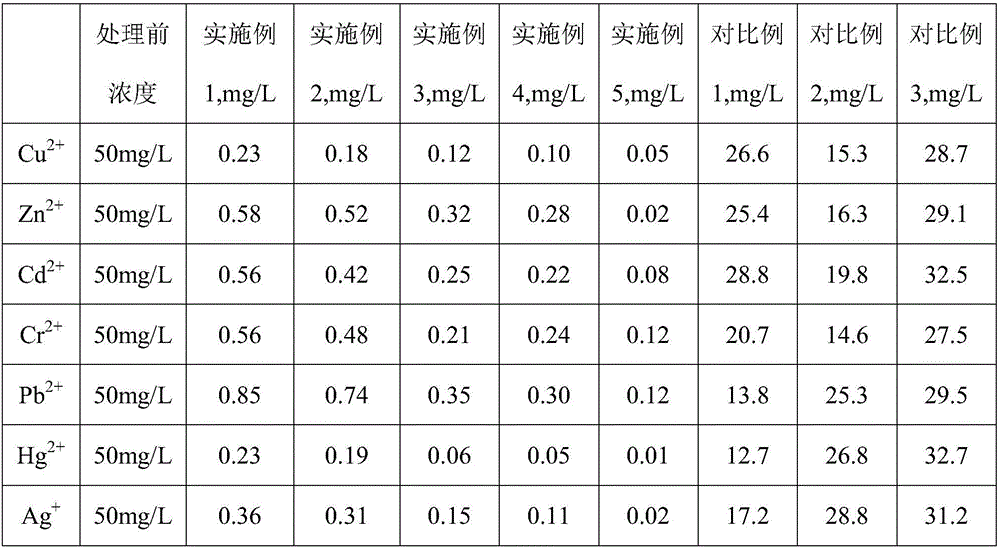Adsorbent for treating heavy metal wastewater, as well as preparation method and application thereof
A wastewater treatment and adsorbent technology, which is applied in water/sewage treatment, adsorption water/sewage treatment, water/sludge/sewage treatment, etc., can solve the problem of low efficiency of red jade soil adsorption of heavy metals, and achieve high reuse times, High yield and good governance effect
- Summary
- Abstract
- Description
- Claims
- Application Information
AI Technical Summary
Problems solved by technology
Method used
Image
Examples
Embodiment 1
[0017] In the embodiment of the present invention, an adsorbent for heavy metal wastewater treatment is composed of the following raw materials in parts by weight: 31 parts of red jade, 1 part of thioglycolic acid, 8 parts of acrylamide, and 23 parts of polyethylene glycol.
[0018] The polyethylene glycol solution was prepared by mixing polyethylene glycol with 2.6 times the mass of deionized water. The red jade soil and acrylamide were mixed and ground, passed through a 120-mesh sieve, then a polyethylene glycol solution was added, the temperature was raised to 65 ° C, and the temperature was ultrasonically treated for 27 min. The ultrasonic power was 1000 W, and then thioglycolic acid was added dropwise. After completion, the temperature was raised to 118 °C and sealed and stirred at this temperature for 75 minutes, then microwaved for 15 minutes, the microwave power was 1000W, and then stirred at 99 °C until dry, and then calcined in a muffle furnace at 430 °C for 4.3h The...
Embodiment 2
[0021] In the embodiment of the present invention, an adsorbent for heavy metal wastewater treatment is composed of the following raw materials in parts by weight: 39 parts of red jade, 5 parts of thioglycolic acid, 16 parts of acrylamide, and 31 parts of polyethylene glycol.
[0022] The polyethylene glycol solution was prepared by mixing polyethylene glycol with 2.6 times the mass of deionized water. The red jade soil and acrylamide were mixed and ground, passed through a 120-mesh sieve, then a polyethylene glycol solution was added, the temperature was raised to 65 ° C, and the temperature was ultrasonically treated for 27 min. The ultrasonic power was 1000 W, and then thioglycolic acid was added dropwise. After completion, the temperature was raised to 118°C and sealed and stirred at this temperature for 75min, then microwaved for 15min, the microwave power was 1000W, and then stirred at 101°C until dry, and then calcined in a muffle furnace at 430°C for 4.3h The adsorbent...
Embodiment 3
[0025] In the embodiment of the present invention, an adsorbent for heavy metal wastewater treatment is composed of the following raw materials in parts by weight: 33 parts of red jade, 2 parts of thioglycolic acid, 10 parts of acrylamide, and 25 parts of polyethylene glycol.
[0026] The polyethylene glycol solution was prepared by mixing polyethylene glycol with 2.6 times the mass of deionized water. The red jade soil and acrylamide were mixed and ground, passed through a 120-mesh sieve, then a polyethylene glycol solution was added, the temperature was raised to 65 ° C, and the temperature was ultrasonically treated for 27 min. The ultrasonic power was 1000 W, and then thioglycolic acid was added dropwise. After completion, the temperature was raised to 118 °C and sealed and stirred at this temperature for 75 minutes, then microwaved for 15 minutes, the microwave power was 1000W, and then stirred at 100 °C until dry, and then calcined in a muffle furnace at 430 °C for 4.3h ...
PUM
| Property | Measurement | Unit |
|---|---|---|
| adsorption capacity | aaaaa | aaaaa |
| adsorption capacity | aaaaa | aaaaa |
| adsorption capacity | aaaaa | aaaaa |
Abstract
Description
Claims
Application Information
 Login to View More
Login to View More - R&D
- Intellectual Property
- Life Sciences
- Materials
- Tech Scout
- Unparalleled Data Quality
- Higher Quality Content
- 60% Fewer Hallucinations
Browse by: Latest US Patents, China's latest patents, Technical Efficacy Thesaurus, Application Domain, Technology Topic, Popular Technical Reports.
© 2025 PatSnap. All rights reserved.Legal|Privacy policy|Modern Slavery Act Transparency Statement|Sitemap|About US| Contact US: help@patsnap.com

